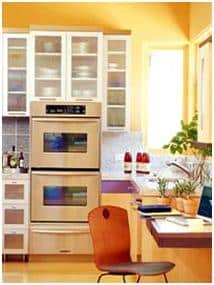
Shocked by the bid for your kitchen remodeling project? Use the following tips to trim expenses on cabinets, flooring, and more while still getting a great look.
Low-cost fix-ups
The kitchen’s role has expanded over the past century, growing from an out-of-the-way service area to a room that’s central both physically and functionally to the home.
It’s no surprise that a room so significant presents costs so large during remodeling. The average kitchen remodeling project costs more than $30,000, according to the National Kitchen & Bath Association, making it one of the most expensive remodeling projects homeowners undertake.
You may be surprised, however, at how many costs you can cut from your kitchen project’s daunting initial bid.
Here are 20 places you can trim your budget, whether you’re hoping to spruce up your existing kitchen for a few bucks or overhaul the entire floor plan and bring in all-new materials.
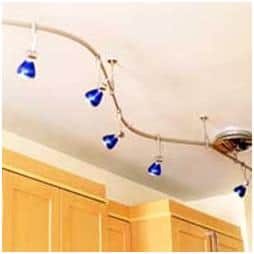
New light fixtures can change the mood of a kitchen.
Lighting and paint
Lighting. A sure way to avoid big-ticket expenses is to spruce up your existing kitchen rather than overhaul it, and new lighting is one of the fastest ways to lift a kitchen’s mood and usefulness.
Halogen lamps are a good way to bounce light off the ceiling for indirect working light, and most come with dimmers so you can turn them down for more subtle lighting. For task and accent lighting, you can easily mount and plug in thin lights under cabinets — no wiring work required. New fixtures over a sink, island, or peninsula can boost performance and appearance.
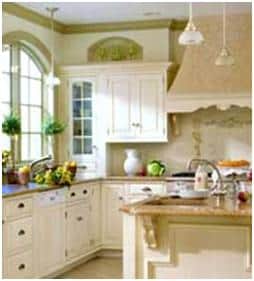
Painted wood adds to the character of a kitchen.
Paint
There’s nothing sacred about stained wood. Painted wood is just as appropriate in many kitchens, and paint lets you get the color and finish you want at a fraction of the cost of refinishing cabinets — even if you hire a painter.
Appliance refinishing companies and even automobile paint shops can provide new complexions for your old range, refrigerator, or dishwasher for about $200. Just be sure you don’t invest in a new look for an appliance that has only a couple of years of use left.
Special do-it-yourself wall-painting jobs, such as sponging, mottling, and rag-rolling, are a good way to divert attention from other less-attractive elements.
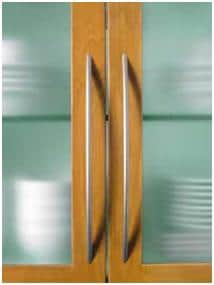
Cabinet hardware adds subtle style to kitchen cabinets.
Hardware and molding
Hardware. New knobs and pulls on cabinets can add sparkle and life. Choose among glass, metal, rubber, wood, resin, and stone, and feel free to use multiple materials and styles to give kitchens a lift.
Molding. Featureless kitchens can benefit greatly from new moldings. Use crown moldings at the ceiling, install a chair rail or plate rail partway up the wall, and replace trim around windows and doors to create shape and detail.
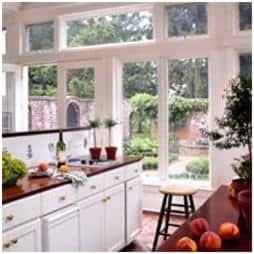
Floor plans
Additions. Better kitchens aren’t always bigger. It’s often wiser in terms of design and finances to reconfigure existing space than to build new. Adding on means buying exterior materials such as siding and roofing to tie the addition to the original house, enlarging the foundation or basement, dealing with lot-line restrictions, and extending the plumbing, wiring, and ductwork.
Instead of extending out, look inside to find possibilities. Removing interior walls usually costs less than adding exterior walls, and the hallways, closets, and stairwells that adjoin kitchens in many older homes provide prime opportunities for annexing space.
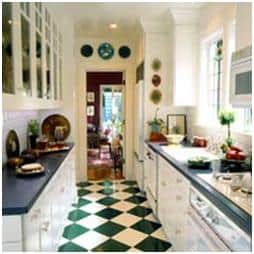
Galleys. When you’re considering efficient layouts, think about galley kitchens. You may not want a kitchen like those on a boat or in a motor home, but the functionality crammed into those kitchens is hard to resist.
For a feeling of spaciousness, devise a relatively compact cooking area and devote leftover space to a seating or eating area. Or open the kitchen to an adjoining dining room or family room, dividing the two spaces with an island or peninsula. A large bay window and a skylight are good ways to give a modest kitchen an expansive outlook without adding square footage.
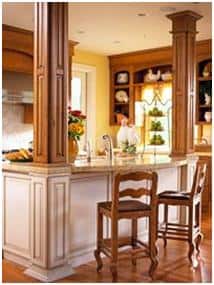
Islands increase the performance of a kitchen.
Islands. Simply adding an island can improve looks and performance in many kitchens. Islands are flexible design elements because they don’t have to match the surrounding cabinets; antique tables often make great islands. If the island holds the sink or cooktop, it often creates a more convenient floor plan and more work space.
Pantries. Adding a pantry to your floor plan cuts cabinet costs. Pantries provide versatile storage and, depending on the style you choose, often require only an abundance of inexpensive shelving. Even a closet-size pantry can replace an entire wall of expensive cabinets, along with the countertops, backsplashes, and extra hinges and knobs that go with them.
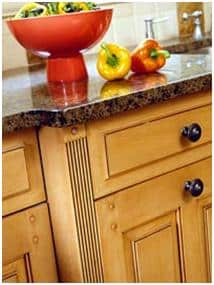
Cabinetry
Quality new cabinets. When you’re shopping for new cabinets, paying more for good ones is a smart investment. Look for high-quality construction and well-engineered features such as built-in spice racks, pop-up appliance platforms, pullout cutting boards, and appliance garages.
Don’t think, though, that higher cost always means higher quality. Imported cabinets typically cost more than American cabinets, but it’s often impossible to tell the two apart. Within a manufacturer’s product line, plainer cabinet designs that match the quality of fancier units may cost significantly less. Attractive kitchens can use simple cabinets that stay in the background while glamor elements such as a centerpiece island or tiled backsplash draw attention.
Inexpensive custom cabinets. Don’t assume custom cabinets from a local cabinet shop cost too much. A local shop may offer you a better price, especially if you order well in advance so the project can be done during the off-season. Watch for ads from cabinet dealers who are updating their showrooms. You could buy their old display cabinets at a savings of 30 to 40 percent, but make sure you don’t buy dated-looking cabinets.
Mixed looks. Well-designed kitchens don’t require completely matched cabinetry, so if you like a mixed look, shop architectural salvage yards, antiques stores, and flea markets for hutches, china cabinets, and buffets you can use in your plans. A vintage armoire or a stately bookcase can work like a pantry cabinet and bring a furniture look to the kitchen, while tables can make charming islands.
Reusing cabinets. Cabinets make up one-third to one-half of the cost of most kitchens, so good planning here has a large effect on your budget. For example, remember that new cabinets aren’t your only option. New countertops and backsplashes could give existing cabinets a new lease on life. If the cabinets are structurally sound but visually unappealing, consider replacing or refacing just the doors and drawer fronts.
Salvaged cabinets also can be a good resource. Ask local kitchen showrooms and cabinet shops, contractors, friends, relatives, and neighbors to watch for reusable cabinets from other homes. Watch the costs, though, because stripping, refinishing, repairing, and altering old cabinets can cost more than new ones.
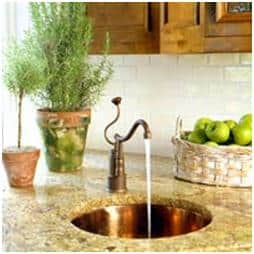
Counter and appliances
Calculated luxuries. Saving money on cabinets can free funds for countertop upgrades. If you select laminate, add bullnose edges or a wood strip for a decorative look. Solid-surfacing products cost more for materials and installation, but they can update the kitchen quickly. The same goes for ceramic tile, granite, marble, and butcher block.
More mixed materials. No design law dictates that all of a kitchen’s countertops must be the same material. Use laminate (up to $50 per linear foot) for most of the counters, and reserve granite ($150 and more per linear foot) for the island. Install a granite tile backsplash above a solid-surfacing or laminate countertop. If you prefer ceramic tile, choose an affordable American-made tile as a field tile and save expensive imported or hand-painted tile for decorative accents.
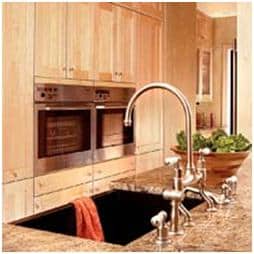
Appliances
Buying what matters. When it comes to appliances, buy as much energy-efficiency and quality as you can afford. In cooking appliances, focus on power, not gee-whiz features you may never use. That means picking at least one high-heat burner and one ultra-low-heat burner. Five- and six-burner ranges and cooktops are worthwhile for frequent cooking because much modern meal preparation uses the stove rather than the oven.
Double ovens. Plans to install a double oven are a prime place to trim $500-$1,500. Many people find they rarely need to roast and bake at the same time, plus recent advances in oven technology let you cook two or three dishes consecutively in a single oven in the time one dish would have required a few years ago. To keep all dishes warm for simultaneous serving, consider a microwave oven that also offers convection baking.
Built-in refrigerators. If a built-in fridge costing $5,000 or so busts the budget, buy a freestanding model for about $1,000 and have the contractor give it a built-in look. Building an alcove and surrounding cabinets costs about one-third or one-half as much as a true built-in. Panel kits from companies such as Frigo Design (800-836-8746) give appliances a high-end look for $250-$700.
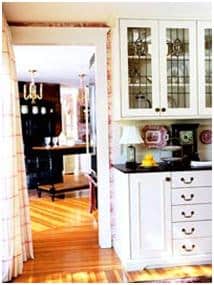
Tile. Shop for discontinued colors or patterns that are marked down. Or use a neutral-hue tile as a field tile and more expensive tiles for color or pattern accents.
Vinyl flooring. Vinyl tile or sheet vinyl can greatly enhance kitchens, particularly when the floor isn’t a focal point. Even then, a checkerboard pattern made of solid black-and-white vinyl tiles, or another similar pattern, adds drama on a shoestring budget. Faux-stone vinyl and laminate flooring can create the look of granite or marble at bargain prices.
Hidden treasure. Check for buried treasure under older kitchens’ well-worn linoleum or vinyl flooring. You may find a salvageable wood floor that’s worth the cost of refinishing. That kind of hidden bonus can free a few more dollars to put toward the luxury items you want.
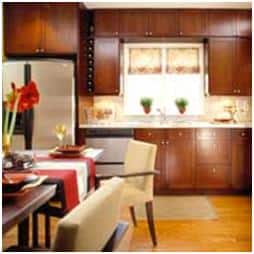
Labor costs and value
Don’t skimp on skilled help
One final note: If you have to cut budget corners, economize on materials so you can hire the skilled help you need. By making the most of your budget and preventing costly mistakes, architects, interior designers, or kitchen designers can save you from substantial headaches and often cover the cost of their services. A kitchen designer typically charges $1,000 to $6,000 or more for a floor plan.
Design professionals frequently can solicit more competitive bids for the construction portion of the job. You can advertise for bids yourself, but without a highly detailed plan and specifications from a professional, estimates will be less reliable.
Another advantage to hiring pros is that talented carpenters, cabinetmakers, tile setters, and stonemasons can make even inexpensive materials look good.
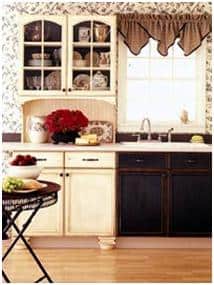
Where you can save
Demolition and cleanup are two areas where most homeowners can get involved and reduce labor costs. You may be able to save several thousand dollars by doing it yourself and put that money toward better materials.
If friends help, make sure your homeowner’s policy covers on-the-job injuries to volunteers, and always consult an architect or another professional before demolition to ensure you aren’t removing any load-bearing walls or other key structural elements.
